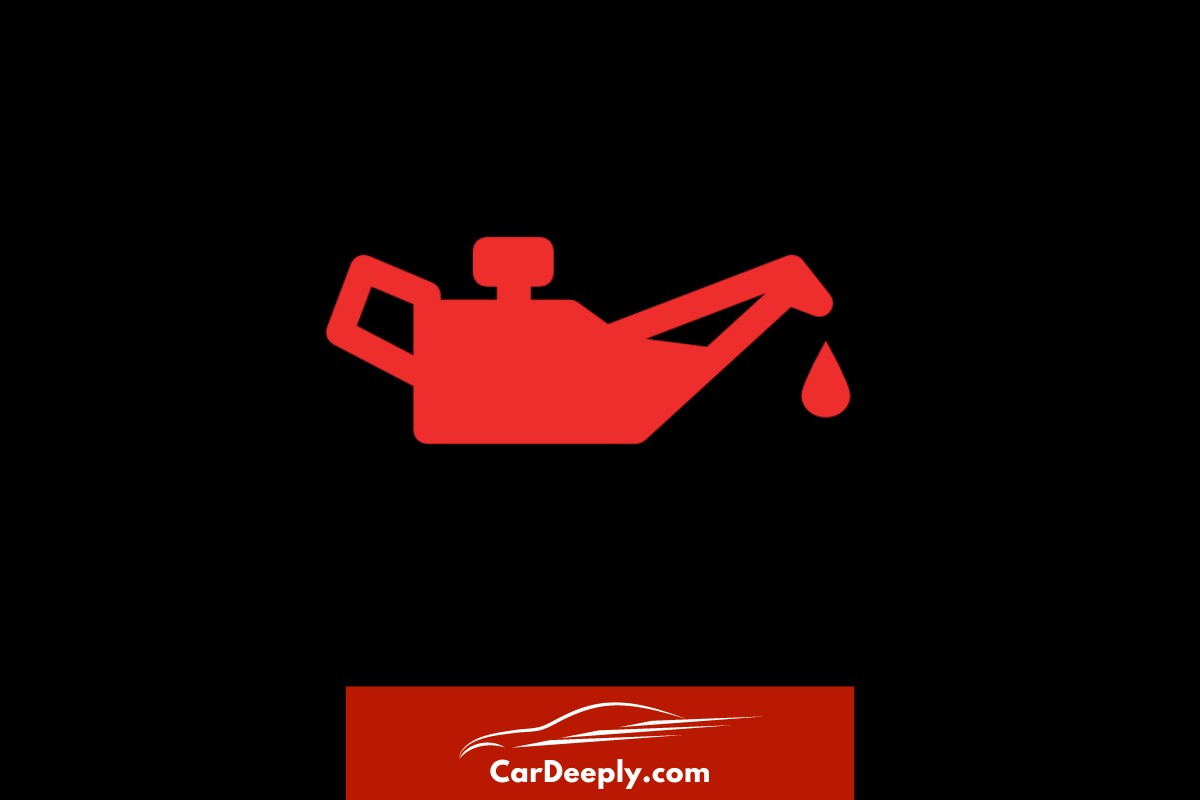Have you ever noticed your car’s oil pressure warning light?
A sudden illumination of that small icon on your dashboard may perplex you as to what it means and what to do next. But: It is essential to know the meaning because it is one of the most common car dashboard warning lights.
In this post, we’ll explore all the vital details you require concerning this warning light. We’ve covered everything from the reasons for low and high oil pressure to what to do when the light turns on. We’ll also offer some advice on how to avoid future oil pressure issues.
To understand everything there is to know about the oil pressure warning light, let’s get started.
Advertising links are marked with *. We receive a small commission on sales, nothing changes for you.
Oil Pressure Warning Light: Key Takeaways

- The oil pressure warning light is a red or yellow oil can-shaped light on the dashboard.
- Low oil pressure can cause the light to come on and can be caused by oil leaks, sensor problems, and worn-out bearings.
- High oil pressure can also cause the light to come on and can be caused by clogged passages, faulty relief valves, and using the wrong type of oil.
- Immediate action should be taken when the oil pressure warning light comes on to prevent further engine damage.
- Regular maintenance, oil changes, and inspections can help prevent future oil pressure problems and keep the engine running smoothly.
The Oil Pressure Warning Light: What Sets It Off?
Many factors, such as low oil pressure or high oil pressure, might cause the oil pressure warning light to illuminate.
To prevent further harm to your car’s engine, treating the problem as soon as the light illuminates is critical.
Let’s take a look at both: High and low oil pressure!
Low Oil Pressure
Several things, including oil leaks, broken oil pressure sensors, and worn-out engine bearings, can contribute to low oil pressure.
It’s critical to stop the car when you hear unusual engine noises or the low oil pressure warning light and check the oil level.
Check for leaks after topping off the oil if it is low. It is advised to take your automobile to a qualified mechanic to check the oil pressure sensor and engine bearings to see if the oil level is average.
Causes of Low Oil Pressure:
- Oil Leaks: Several factors, such as faulty gaskets or seals, slack oil filters, or damaged oil pans, can lead to oil leaks. Your car’s oil pressure may drop if there is an oil leak, which could cause the oil pressure warning light to illuminate.
- Damaged Oil Pressure Sensor: The oil pressure sensor is responsible for gauging oil pressure and communicating information to the vehicle’s computer system. The oil pressure warning light may illuminate if the sensor is defective or damaged because of erroneous readings.
- Engine bearings that are worn out: Engine bearings lower friction between the engine’s moving parts. These bearings may deteriorate with time, reducing the oil pressure and turning on the oil pressure warning light.
High Oil Pressure
The oil pressure warning light may also illuminate due to high oil pressure.
The incorrect oil type, clogged oil passageways, or broken oil pressure relief valves can contribute to high oil pressure.
High oil pressure can cause engine damage and oil leakage, among other symptoms. Taking your car to a qualified mechanic for inspection and diagnostics is advised if you suspect it has high oil pressure.
Regular engine maintenance is crucial to preventing oil pressure issues.
Future oil pressure problems can be avoided by doing regular oil changes, using the right oil, keeping the proper oil levels, and quickly fixing any oil leaks.
High oil pressure causes:
- Clogged Oil Passages: Sludge or debris buildup in the engine can cause clogged oil passageways. As a result, the oil pressure may rise, and the oil pressure warning light may illuminate.
- Damaged Oil Pressure Relief Valve: The oil pressure relief valve keeps the engine’s oil pressure steady. The oil pressure warning light may turn on due to fluctuating oil pressure caused by a defective or malfunctioning valve.
- Using the Improper Kind of Oil: Using the wrong oil type might impact your car’s oil pressure. Use only the appropriate oil type and viscosity listed in your car’s manual.
When the Oil Pressure Warning Light Is On, What Should I Do?
To avoid further harm to your car’s engine, you must act right away if you see the oil pressure warning light turns on.
To solve the problem, take these actions:
Step 1: Quickly stop the vehicle (important!)
Pull over to a safe location when the oil pressure warning light turns on, and switch the vehicle off.
Driving on might seriously harm the engine of the car.
Check the oil level in Step 2
Use the dipstick beneath the hood or the automatic oil level measurement to check the oil level.
If your car’s oil level is low, top it off using the oil type and viscosity advised in the owner’s manual.
Inspect for oil leaks in step 3
Look for any indications of oil leaks under the car and in the engine compartment.
Having any leaks corrected by a qualified mechanic as soon as you find them is critical.
Inspect the oil pressure sensor in Step 4
The oil pressure sensor keeps track of the oil pressure and communicates with the vehicle’s computer system.
The oil pressure warning light may illuminate if the sensor is defective or damaged because of erroneous readings.
Let a mechanic check the sensor and, if necessary, replace it.
Inspect the oil pressure relief valve in step five.
The oil pressure relief valve is in charge of keeping the oil pressure in the engine constant.
The oil pressure warning light may turn on if the valve is broken or defective. Have the valve checked, and if necessary, have it replaced.
Step 6: Check the Engine Bearings
Low oil pressure can be brought on by worn-out engine bearings, which will illuminate the oil pressure warning light.
Have the engine bearings checked, and if necessary, have them replaced.
Step 7: Refill or replace the oil
Fill up or replace the oil as soon as possible if it’s unclean or low on oil. Oil pressure issues may be avoided using the proper oil type and viscosity.
Guidelines for Avoiding Oil Pressure Issues
Maintaining the proper oil pressure in your car is essential to keeping your engine in good working order. Here are some suggestions to assist you in preventing future issues with oil pressure:
#1: Routine oil changes
Maintaining your car’s engine’s optimum oil level and viscosity requires routine oil changes.
You should change the oil every 5,000 to 7,500 miles or as specified in your car’s owner’s manual.
#2: Examine for Oil Leaks
Check your car frequently for any indications of oil leakage. Then, to avoid low oil pressure, have any leaks rectified right once you find them.
#3: Choose the Correct Oil Type
Oil pressure issues can be avoided using the proper oil and viscosity as instructed in your car’s owner’s manual.
Low oil pressure can be caused by incorrect oil, increasing engine wear and friction.
Which oil is best for your car? Use the Mobil Search here.
#4: Inspect the Relief Valve and Oil Pressure Sensor
Have the oil pressure sensor and relief valve frequently checked to ensure they operate correctly.
Faulty or broken sensors and valves can cause oil pressure changes and erroneous readings.
#5: Maintain Engine Cleanliness
Oil sludge buildup, which can clog oil passageways and result in high oil pressure, can be avoided with the help of a clean engine.
According to the owner’s manual for your car, you should routinely clean the engine compartment and replace the air filter.
By adhering to these suggestions, you can prevent oil pressure issues with your car and save money on repairs. In addition, your engine may operate smoothly and efficiently by performing routine maintenance and giving any problems early attention.

Sebastian loves convertibles and drove a BMW 335i for a long time (325 hp is just a dream). Today, with two children, he is more concerned with SUVs and family-friendly vehicles. In addition to an Audi A4 Avant, he also drives a Cupra Formentor VZ – even as a family man, you can’t do without speed. Get to know Sebastian better and visit the About Us page.
Advertising links are marked with *. We receive a small commission on sales, nothing changes for you.
